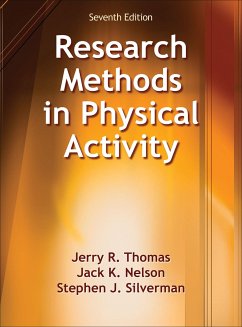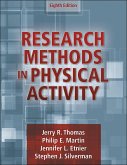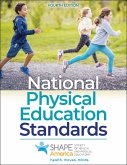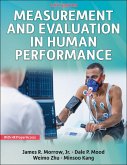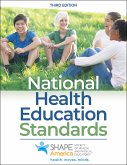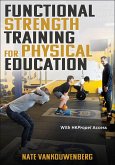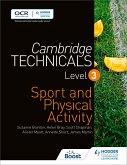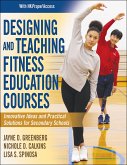- Gebundenes Buch
- Merkliste
- Auf die Merkliste
- Bewerten Bewerten
- Teilen
- Produkt teilen
- Produkterinnerung
- Produkterinnerung
Research Methods in Physical Activity, Seventh Edition, offers step-by-step information for every aspect of the research process, providing guidelines for conducting and compiling research so that students feel capable and confident.
Andere Kunden interessierten sich auch für
![Research Methods in Physical Activity Research Methods in Physical Activity]() Jerry R. ThomasResearch Methods in Physical Activity142,99 €
Jerry R. ThomasResearch Methods in Physical Activity142,99 €![National Physical Education Standards National Physical Education Standards]() SHAPE America - Society of Health and Physical EducatorsNational Physical Education Standards48,99 €
SHAPE America - Society of Health and Physical EducatorsNational Physical Education Standards48,99 €![Measurement and Evaluation in Human Performance Measurement and Evaluation in Human Performance]() Morrow, James R., Jr.Measurement and Evaluation in Human Performance142,99 €
Morrow, James R., Jr.Measurement and Evaluation in Human Performance142,99 €![National Health Education Standards National Health Education Standards]() SHAPE America - Society of Health and Physical EducatorsNational Health Education Standards50,99 €
SHAPE America - Society of Health and Physical EducatorsNational Health Education Standards50,99 €![Functional Strength Training for Physical Education Functional Strength Training for Physical Education]() Nate VanKouwenbergFunctional Strength Training for Physical Education51,99 €
Nate VanKouwenbergFunctional Strength Training for Physical Education51,99 €![Cambridge Technicals Level 3 Sport and Physical Activity Cambridge Technicals Level 3 Sport and Physical Activity]() Helen BrayCambridge Technicals Level 3 Sport and Physical Activity53,99 €
Helen BrayCambridge Technicals Level 3 Sport and Physical Activity53,99 €![Designing and Teaching Fitness Education Courses Designing and Teaching Fitness Education Courses]() Jayne D. GreenbergDesigning and Teaching Fitness Education Courses73,99 €
Jayne D. GreenbergDesigning and Teaching Fitness Education Courses73,99 €-
-
-
Research Methods in Physical Activity, Seventh Edition, offers step-by-step information for every aspect of the research process, providing guidelines for conducting and compiling research so that students feel capable and confident.
Hinweis: Dieser Artikel kann nur an eine deutsche Lieferadresse ausgeliefert werden.
Hinweis: Dieser Artikel kann nur an eine deutsche Lieferadresse ausgeliefert werden.
Produktdetails
- Produktdetails
- Verlag: Human Kinetics Publishers
- Seventh Edition
- Seitenzahl: 496
- Erscheinungstermin: 17. Juli 2015
- Englisch
- Abmessung: 291mm x 228mm x 32mm
- Gewicht: 1496g
- ISBN-13: 9781450470445
- ISBN-10: 1450470440
- Artikelnr.: 42649994
- Herstellerkennzeichnung
- Libri GmbH
- Europaallee 1
- 36244 Bad Hersfeld
- gpsr@libri.de
- Verlag: Human Kinetics Publishers
- Seventh Edition
- Seitenzahl: 496
- Erscheinungstermin: 17. Juli 2015
- Englisch
- Abmessung: 291mm x 228mm x 32mm
- Gewicht: 1496g
- ISBN-13: 9781450470445
- ISBN-10: 1450470440
- Artikelnr.: 42649994
- Herstellerkennzeichnung
- Libri GmbH
- Europaallee 1
- 36244 Bad Hersfeld
- gpsr@libri.de
Jerry R. Thomas, EdD, is professor and dean of the College of Education at the University of North Texas. Besides writing the previous editions of this book, Thomas has authored more than 200 publications, 120 of which are refereed publications with numerous contributions in research methods. In 1999 he was named the C.H. McCloy Lecturer for his production of research throughout his career. Thomas has been editor in chief of Research Quarterly for Exercise and Sport and a reviewer for most major research journals in kinesiology and numerous journals in psychology. He has also served as president of the National Academy of Kinesiology, American Kinesiology Association, AAHPERD Research Consortium, and North American Society for Psychology of Sport and Physical Activity. In 1990 he was named an AAHPERD Alliance Scholar and in 2003 was named a NASPSPA Distinguished Scholar based on lifetime achievement in research. Thomas received an honorary doctorate of science from his undergraduate institution, Furman University, in the spring of 2015. Jack K. Nelson, EdD, is professor emeritus in the department of kinesiology at Louisiana State University. Nelson conducted and published research and taught research methods for 35 years. He has been an adviser on more than 50 doctoral dissertations and more than 50 master's theses. He has more than 80 publications and has served as editor of research publications. A fellow in the Research Consortium, he has been a member of AAHPERD, the American Educational Research Association, and the American College of Sports Medicine. He has also served as president of the Association for Research, Administration, Professional Councils and Societies (now AAALF) and as vice president of AAHPERD. Stephen Silverman, EdD, has taught and written about research methods for more than 30 years. He is a professor of education at Teachers College at Columbia University and has conducted research on teaching in physical education focusing on how children learn motor skill and develop attitudes. He has published more than 75 research articles in addition to many books and book chapters. Silverman is a fellow and past president of the National Academy of Kinesiology and the American Alliance for Health, Physical Education, Recreation and Dance (AAHPERD) Research Consortium and a fellow of the American Educational Research Association (AERA). A former coeditor of the Journal of Teaching in Physical Education and editor in chief of the Research Quarterly for Exercise and Sport, Silverman was an AERA Physical Education scholar lecturer, a Research Consortium scholar lecturer, and Weiss lecturer and Alliance Scholar for AAHPERD.
Part I: Overview of the Research Process
Chapter 1. Introduction to Research in Physical Activity
The Nature of Research
Unscientific Versus Scientific Methods of Problem Solving
Alternative Models of Research
Types of Research
Overview of the Research Process
Parts of a Thesis: A Reflection on the Steps in the Research Process
Summary
Chapter 2. Developing the Problem and Using the Literature
Identifying the Research Problem
Purpose of the Literature Review
Basic Literature Search Strategies
Steps in the Literature Search
Summary
Chapter 3. Presenting the Problem
Choosing the Title
Writing the Introduction
Stating the Research Problem
Presenting the Research Hypothesis
Operationally Defining Terms
Basic Assumptions, Delimitations, and Limitations
Justifying the Significance of the Study
Differences Between the Thesis and the Research Article
Summary
Chapter 4. Formulating the Method
How to Present Methodological Details
Why Planning the Method Is Important
Two Principles for Planning Experiments
Describing Participants
Describing Instruments
Describing Procedures
Describing Design and Analysis
Establishing Cause and Effect
Interaction of Participants, Measurements, and Treatments
Summary
Chapter 5. Ethical Issues in Research and Scholarship
Seven Areas of Scientific Dishonesty
Ethical Issues Regarding Copyright
Model for Considering Scientific Misconduct
Working With Faculty
Protecting Human Participants
Protecting Animal Subjects
Summary
Part II: Statistical and Measurement Concepts in Research
Chapter 6. Becoming Acquainted With Statistical Concepts
Why We Need Statistics
Use of Computers in Statistical Analysis
Description and Inference Are Not Statistical Techniques
Ways to Select a Sample
Justifying Post Hoc Explanations
Difficulty of Random Sampling and Assignment: How Good Does It Have to Be?
Unit of Analysis
Measures of Central Tendency and Variability
Basic Concepts of Statistical Techniques
Data for Use in the Remaining Statistical Chapters
Summary
Chapter 7. Statistical Issues in Research Planning and Evaluation
Probability
Meaningfulness (Effect Size)
Power
Using Information in the Context of the Study
Summary
Chapter 8. Relationships Among Variables
What Correlational Research Investigates
Understanding the Nature of Correlation
What the Coefficient of Correlation Means
Using Correlation for Prediction
Partial Correlation
Uses of Semipartial Correlation
Procedures for Multiple Regression
Logistic Regression
Discriminant Function AnalysisMultivariate Forms of Correlation
Summary
Chapter 9. Differences Among Groups
How Statistics Test Differences
Types of t Tests
Interpreting t
Relationship of t and r
Analysis of Variance
Analysis of Covariance
Experimentwise Error Rate
Understanding Multivariate Techniques
Summary
Chapter 10. Nonparametric Techniques
Chi Square: Testing the Observed Versus the Expected
Procedures for Rank-Order Data
Correlation
Differences Among Groups
Summary
Chapter 11. Measuring Research Variables
Validity
Reliability
Methods of Establishing Reliability
Intertester Reliability (Objectivity)
Standard Error of Measurement
Using Standard Scores to Compare Performance
Measuring Movement
Measuring Written Responses
Measuring Affective Behavior
Scales for Measuring Affective Behavior
Measuring Knowledge
Item Response Theory
Summary
Part III: Types of Research
Chapter 12. Sociohistorical Process in Sport Studies
David K. Wiggins and Daniel S. Mason
Development of the Discipline Theory and Sport History
Relationship Between Theory and Method
Research Goals and Questions
Research Topics
Research Design
Data Analysis and Interpretation
Research Findings
Exemplary Studies in Sport History
Summary
Chapter 13. Philosophical Research in Physical Activity
R. Scott Kretchmar and Tim Elcombe
Identifying the Purposes of Philosophical Research
Identifying the Range of Philosophical Research
Locating a Research Problem
Analyzing a Research Problem
Summary
Chapter 14. Research Synthesis (Meta-Analysis)
Using Meta-Analysis to Synthesize Research
Presenting Effect Size Data
Summary
Chapter 15. Surveys
Questionnaires
Electronic Surveys
Delphi Method
Personal Interviews
Normative Surveys
Summary
Chapter 16. Other Descriptive Research Methods
Developmental Research
Case Studies
Job Analysis
Observational Research
Unobtrusive Research Techniques
Correlational Research
Summary
Chapter 17. Physical Activity Epidemiology Research
Barbara E. Ainsworth and Charles E. Matthews
Observational Versus Experimental Research
What Is Epidemiology?
Physical Activity Measurement Definitions
Assessment of Physical Activity
Epidemiological Study Designs
Reading and Interpreting a Physical Activity Epidemiological Study
Summary
Chapter 18. Experimental and Quasi-Experimental Research
Sources of Invalidity
Threats to Internal Validity
Threats to External Validity
Controlling Threats to Internal Validity
Controlling Threats to External Validity
Types of Designs
Summary
Chapter 19. Qualitative Research
Procedures in Qualitative Research
Analysis of the Data
Concluding Remarks
Summary
Chapter 20. Mixed-Methods Research
Combining Quantitative and Qualitative Methods
Designing Mixed-Methods Research
Issues in Mixed-Methods Research
Examples of Mixed-Methods Research
Summary
Part IV: Writing the Research Report
Chapter 21. Completing the Research Process
Research Proposal
Thesis and Dissertation Proposal
Advisor and Dissertation Committee
The Good Scholar Must Research and Write
Scientific Writing
First Things Are Sometimes Best Done Last
Developing a Good Introduction
Describing the Method
The Proposal Process
Preparing and Presenting Qualitative Research Proposals
Writing Proposals for Granting Agencies
Submitting Internal Proposals
Completing Your Thesis or Dissertation
Results and Discussion
Handling Multiple Experiments in a Single Report
Using Tables and Figures
Summary
Chapter 22. Ways of Reporting Research
Basic Writing Guidelines
A Brief Word About Acknowledgments
Thesis and Dissertation Format: Traditional Versus Journal
Helpful Hints for Successful Journal Writing
Revising Research Papers
Writing Abstracts
Making Oral and Poster Presentations
Summary
Chapter 1. Introduction to Research in Physical Activity
The Nature of Research
Unscientific Versus Scientific Methods of Problem Solving
Alternative Models of Research
Types of Research
Overview of the Research Process
Parts of a Thesis: A Reflection on the Steps in the Research Process
Summary
Chapter 2. Developing the Problem and Using the Literature
Identifying the Research Problem
Purpose of the Literature Review
Basic Literature Search Strategies
Steps in the Literature Search
Summary
Chapter 3. Presenting the Problem
Choosing the Title
Writing the Introduction
Stating the Research Problem
Presenting the Research Hypothesis
Operationally Defining Terms
Basic Assumptions, Delimitations, and Limitations
Justifying the Significance of the Study
Differences Between the Thesis and the Research Article
Summary
Chapter 4. Formulating the Method
How to Present Methodological Details
Why Planning the Method Is Important
Two Principles for Planning Experiments
Describing Participants
Describing Instruments
Describing Procedures
Describing Design and Analysis
Establishing Cause and Effect
Interaction of Participants, Measurements, and Treatments
Summary
Chapter 5. Ethical Issues in Research and Scholarship
Seven Areas of Scientific Dishonesty
Ethical Issues Regarding Copyright
Model for Considering Scientific Misconduct
Working With Faculty
Protecting Human Participants
Protecting Animal Subjects
Summary
Part II: Statistical and Measurement Concepts in Research
Chapter 6. Becoming Acquainted With Statistical Concepts
Why We Need Statistics
Use of Computers in Statistical Analysis
Description and Inference Are Not Statistical Techniques
Ways to Select a Sample
Justifying Post Hoc Explanations
Difficulty of Random Sampling and Assignment: How Good Does It Have to Be?
Unit of Analysis
Measures of Central Tendency and Variability
Basic Concepts of Statistical Techniques
Data for Use in the Remaining Statistical Chapters
Summary
Chapter 7. Statistical Issues in Research Planning and Evaluation
Probability
Meaningfulness (Effect Size)
Power
Using Information in the Context of the Study
Summary
Chapter 8. Relationships Among Variables
What Correlational Research Investigates
Understanding the Nature of Correlation
What the Coefficient of Correlation Means
Using Correlation for Prediction
Partial Correlation
Uses of Semipartial Correlation
Procedures for Multiple Regression
Logistic Regression
Discriminant Function AnalysisMultivariate Forms of Correlation
Summary
Chapter 9. Differences Among Groups
How Statistics Test Differences
Types of t Tests
Interpreting t
Relationship of t and r
Analysis of Variance
Analysis of Covariance
Experimentwise Error Rate
Understanding Multivariate Techniques
Summary
Chapter 10. Nonparametric Techniques
Chi Square: Testing the Observed Versus the Expected
Procedures for Rank-Order Data
Correlation
Differences Among Groups
Summary
Chapter 11. Measuring Research Variables
Validity
Reliability
Methods of Establishing Reliability
Intertester Reliability (Objectivity)
Standard Error of Measurement
Using Standard Scores to Compare Performance
Measuring Movement
Measuring Written Responses
Measuring Affective Behavior
Scales for Measuring Affective Behavior
Measuring Knowledge
Item Response Theory
Summary
Part III: Types of Research
Chapter 12. Sociohistorical Process in Sport Studies
David K. Wiggins and Daniel S. Mason
Development of the Discipline Theory and Sport History
Relationship Between Theory and Method
Research Goals and Questions
Research Topics
Research Design
Data Analysis and Interpretation
Research Findings
Exemplary Studies in Sport History
Summary
Chapter 13. Philosophical Research in Physical Activity
R. Scott Kretchmar and Tim Elcombe
Identifying the Purposes of Philosophical Research
Identifying the Range of Philosophical Research
Locating a Research Problem
Analyzing a Research Problem
Summary
Chapter 14. Research Synthesis (Meta-Analysis)
Using Meta-Analysis to Synthesize Research
Presenting Effect Size Data
Summary
Chapter 15. Surveys
Questionnaires
Electronic Surveys
Delphi Method
Personal Interviews
Normative Surveys
Summary
Chapter 16. Other Descriptive Research Methods
Developmental Research
Case Studies
Job Analysis
Observational Research
Unobtrusive Research Techniques
Correlational Research
Summary
Chapter 17. Physical Activity Epidemiology Research
Barbara E. Ainsworth and Charles E. Matthews
Observational Versus Experimental Research
What Is Epidemiology?
Physical Activity Measurement Definitions
Assessment of Physical Activity
Epidemiological Study Designs
Reading and Interpreting a Physical Activity Epidemiological Study
Summary
Chapter 18. Experimental and Quasi-Experimental Research
Sources of Invalidity
Threats to Internal Validity
Threats to External Validity
Controlling Threats to Internal Validity
Controlling Threats to External Validity
Types of Designs
Summary
Chapter 19. Qualitative Research
Procedures in Qualitative Research
Analysis of the Data
Concluding Remarks
Summary
Chapter 20. Mixed-Methods Research
Combining Quantitative and Qualitative Methods
Designing Mixed-Methods Research
Issues in Mixed-Methods Research
Examples of Mixed-Methods Research
Summary
Part IV: Writing the Research Report
Chapter 21. Completing the Research Process
Research Proposal
Thesis and Dissertation Proposal
Advisor and Dissertation Committee
The Good Scholar Must Research and Write
Scientific Writing
First Things Are Sometimes Best Done Last
Developing a Good Introduction
Describing the Method
The Proposal Process
Preparing and Presenting Qualitative Research Proposals
Writing Proposals for Granting Agencies
Submitting Internal Proposals
Completing Your Thesis or Dissertation
Results and Discussion
Handling Multiple Experiments in a Single Report
Using Tables and Figures
Summary
Chapter 22. Ways of Reporting Research
Basic Writing Guidelines
A Brief Word About Acknowledgments
Thesis and Dissertation Format: Traditional Versus Journal
Helpful Hints for Successful Journal Writing
Revising Research Papers
Writing Abstracts
Making Oral and Poster Presentations
Summary
Part I: Overview of the Research Process
Chapter 1. Introduction to Research in Physical Activity
The Nature of Research
Unscientific Versus Scientific Methods of Problem Solving
Alternative Models of Research
Types of Research
Overview of the Research Process
Parts of a Thesis: A Reflection on the Steps in the Research Process
Summary
Chapter 2. Developing the Problem and Using the Literature
Identifying the Research Problem
Purpose of the Literature Review
Basic Literature Search Strategies
Steps in the Literature Search
Summary
Chapter 3. Presenting the Problem
Choosing the Title
Writing the Introduction
Stating the Research Problem
Presenting the Research Hypothesis
Operationally Defining Terms
Basic Assumptions, Delimitations, and Limitations
Justifying the Significance of the Study
Differences Between the Thesis and the Research Article
Summary
Chapter 4. Formulating the Method
How to Present Methodological Details
Why Planning the Method Is Important
Two Principles for Planning Experiments
Describing Participants
Describing Instruments
Describing Procedures
Describing Design and Analysis
Establishing Cause and Effect
Interaction of Participants, Measurements, and Treatments
Summary
Chapter 5. Ethical Issues in Research and Scholarship
Seven Areas of Scientific Dishonesty
Ethical Issues Regarding Copyright
Model for Considering Scientific Misconduct
Working With Faculty
Protecting Human Participants
Protecting Animal Subjects
Summary
Part II: Statistical and Measurement Concepts in Research
Chapter 6. Becoming Acquainted With Statistical Concepts
Why We Need Statistics
Use of Computers in Statistical Analysis
Description and Inference Are Not Statistical Techniques
Ways to Select a Sample
Justifying Post Hoc Explanations
Difficulty of Random Sampling and Assignment: How Good Does It Have to Be?
Unit of Analysis
Measures of Central Tendency and Variability
Basic Concepts of Statistical Techniques
Data for Use in the Remaining Statistical Chapters
Summary
Chapter 7. Statistical Issues in Research Planning and Evaluation
Probability
Meaningfulness (Effect Size)
Power
Using Information in the Context of the Study
Summary
Chapter 8. Relationships Among Variables
What Correlational Research Investigates
Understanding the Nature of Correlation
What the Coefficient of Correlation Means
Using Correlation for Prediction
Partial Correlation
Uses of Semipartial Correlation
Procedures for Multiple Regression
Logistic Regression
Discriminant Function AnalysisMultivariate Forms of Correlation
Summary
Chapter 9. Differences Among Groups
How Statistics Test Differences
Types of t Tests
Interpreting t
Relationship of t and r
Analysis of Variance
Analysis of Covariance
Experimentwise Error Rate
Understanding Multivariate Techniques
Summary
Chapter 10. Nonparametric Techniques
Chi Square: Testing the Observed Versus the Expected
Procedures for Rank-Order Data
Correlation
Differences Among Groups
Summary
Chapter 11. Measuring Research Variables
Validity
Reliability
Methods of Establishing Reliability
Intertester Reliability (Objectivity)
Standard Error of Measurement
Using Standard Scores to Compare Performance
Measuring Movement
Measuring Written Responses
Measuring Affective Behavior
Scales for Measuring Affective Behavior
Measuring Knowledge
Item Response Theory
Summary
Part III: Types of Research
Chapter 12. Sociohistorical Process in Sport Studies
David K. Wiggins and Daniel S. Mason
Development of the Discipline Theory and Sport History
Relationship Between Theory and Method
Research Goals and Questions
Research Topics
Research Design
Data Analysis and Interpretation
Research Findings
Exemplary Studies in Sport History
Summary
Chapter 13. Philosophical Research in Physical Activity
R. Scott Kretchmar and Tim Elcombe
Identifying the Purposes of Philosophical Research
Identifying the Range of Philosophical Research
Locating a Research Problem
Analyzing a Research Problem
Summary
Chapter 14. Research Synthesis (Meta-Analysis)
Using Meta-Analysis to Synthesize Research
Presenting Effect Size Data
Summary
Chapter 15. Surveys
Questionnaires
Electronic Surveys
Delphi Method
Personal Interviews
Normative Surveys
Summary
Chapter 16. Other Descriptive Research Methods
Developmental Research
Case Studies
Job Analysis
Observational Research
Unobtrusive Research Techniques
Correlational Research
Summary
Chapter 17. Physical Activity Epidemiology Research
Barbara E. Ainsworth and Charles E. Matthews
Observational Versus Experimental Research
What Is Epidemiology?
Physical Activity Measurement Definitions
Assessment of Physical Activity
Epidemiological Study Designs
Reading and Interpreting a Physical Activity Epidemiological Study
Summary
Chapter 18. Experimental and Quasi-Experimental Research
Sources of Invalidity
Threats to Internal Validity
Threats to External Validity
Controlling Threats to Internal Validity
Controlling Threats to External Validity
Types of Designs
Summary
Chapter 19. Qualitative Research
Procedures in Qualitative Research
Analysis of the Data
Concluding Remarks
Summary
Chapter 20. Mixed-Methods Research
Combining Quantitative and Qualitative Methods
Designing Mixed-Methods Research
Issues in Mixed-Methods Research
Examples of Mixed-Methods Research
Summary
Part IV: Writing the Research Report
Chapter 21. Completing the Research Process
Research Proposal
Thesis and Dissertation Proposal
Advisor and Dissertation Committee
The Good Scholar Must Research and Write
Scientific Writing
First Things Are Sometimes Best Done Last
Developing a Good Introduction
Describing the Method
The Proposal Process
Preparing and Presenting Qualitative Research Proposals
Writing Proposals for Granting Agencies
Submitting Internal Proposals
Completing Your Thesis or Dissertation
Results and Discussion
Handling Multiple Experiments in a Single Report
Using Tables and Figures
Summary
Chapter 22. Ways of Reporting Research
Basic Writing Guidelines
A Brief Word About Acknowledgments
Thesis and Dissertation Format: Traditional Versus Journal
Helpful Hints for Successful Journal Writing
Revising Research Papers
Writing Abstracts
Making Oral and Poster Presentations
Summary
Chapter 1. Introduction to Research in Physical Activity
The Nature of Research
Unscientific Versus Scientific Methods of Problem Solving
Alternative Models of Research
Types of Research
Overview of the Research Process
Parts of a Thesis: A Reflection on the Steps in the Research Process
Summary
Chapter 2. Developing the Problem and Using the Literature
Identifying the Research Problem
Purpose of the Literature Review
Basic Literature Search Strategies
Steps in the Literature Search
Summary
Chapter 3. Presenting the Problem
Choosing the Title
Writing the Introduction
Stating the Research Problem
Presenting the Research Hypothesis
Operationally Defining Terms
Basic Assumptions, Delimitations, and Limitations
Justifying the Significance of the Study
Differences Between the Thesis and the Research Article
Summary
Chapter 4. Formulating the Method
How to Present Methodological Details
Why Planning the Method Is Important
Two Principles for Planning Experiments
Describing Participants
Describing Instruments
Describing Procedures
Describing Design and Analysis
Establishing Cause and Effect
Interaction of Participants, Measurements, and Treatments
Summary
Chapter 5. Ethical Issues in Research and Scholarship
Seven Areas of Scientific Dishonesty
Ethical Issues Regarding Copyright
Model for Considering Scientific Misconduct
Working With Faculty
Protecting Human Participants
Protecting Animal Subjects
Summary
Part II: Statistical and Measurement Concepts in Research
Chapter 6. Becoming Acquainted With Statistical Concepts
Why We Need Statistics
Use of Computers in Statistical Analysis
Description and Inference Are Not Statistical Techniques
Ways to Select a Sample
Justifying Post Hoc Explanations
Difficulty of Random Sampling and Assignment: How Good Does It Have to Be?
Unit of Analysis
Measures of Central Tendency and Variability
Basic Concepts of Statistical Techniques
Data for Use in the Remaining Statistical Chapters
Summary
Chapter 7. Statistical Issues in Research Planning and Evaluation
Probability
Meaningfulness (Effect Size)
Power
Using Information in the Context of the Study
Summary
Chapter 8. Relationships Among Variables
What Correlational Research Investigates
Understanding the Nature of Correlation
What the Coefficient of Correlation Means
Using Correlation for Prediction
Partial Correlation
Uses of Semipartial Correlation
Procedures for Multiple Regression
Logistic Regression
Discriminant Function AnalysisMultivariate Forms of Correlation
Summary
Chapter 9. Differences Among Groups
How Statistics Test Differences
Types of t Tests
Interpreting t
Relationship of t and r
Analysis of Variance
Analysis of Covariance
Experimentwise Error Rate
Understanding Multivariate Techniques
Summary
Chapter 10. Nonparametric Techniques
Chi Square: Testing the Observed Versus the Expected
Procedures for Rank-Order Data
Correlation
Differences Among Groups
Summary
Chapter 11. Measuring Research Variables
Validity
Reliability
Methods of Establishing Reliability
Intertester Reliability (Objectivity)
Standard Error of Measurement
Using Standard Scores to Compare Performance
Measuring Movement
Measuring Written Responses
Measuring Affective Behavior
Scales for Measuring Affective Behavior
Measuring Knowledge
Item Response Theory
Summary
Part III: Types of Research
Chapter 12. Sociohistorical Process in Sport Studies
David K. Wiggins and Daniel S. Mason
Development of the Discipline Theory and Sport History
Relationship Between Theory and Method
Research Goals and Questions
Research Topics
Research Design
Data Analysis and Interpretation
Research Findings
Exemplary Studies in Sport History
Summary
Chapter 13. Philosophical Research in Physical Activity
R. Scott Kretchmar and Tim Elcombe
Identifying the Purposes of Philosophical Research
Identifying the Range of Philosophical Research
Locating a Research Problem
Analyzing a Research Problem
Summary
Chapter 14. Research Synthesis (Meta-Analysis)
Using Meta-Analysis to Synthesize Research
Presenting Effect Size Data
Summary
Chapter 15. Surveys
Questionnaires
Electronic Surveys
Delphi Method
Personal Interviews
Normative Surveys
Summary
Chapter 16. Other Descriptive Research Methods
Developmental Research
Case Studies
Job Analysis
Observational Research
Unobtrusive Research Techniques
Correlational Research
Summary
Chapter 17. Physical Activity Epidemiology Research
Barbara E. Ainsworth and Charles E. Matthews
Observational Versus Experimental Research
What Is Epidemiology?
Physical Activity Measurement Definitions
Assessment of Physical Activity
Epidemiological Study Designs
Reading and Interpreting a Physical Activity Epidemiological Study
Summary
Chapter 18. Experimental and Quasi-Experimental Research
Sources of Invalidity
Threats to Internal Validity
Threats to External Validity
Controlling Threats to Internal Validity
Controlling Threats to External Validity
Types of Designs
Summary
Chapter 19. Qualitative Research
Procedures in Qualitative Research
Analysis of the Data
Concluding Remarks
Summary
Chapter 20. Mixed-Methods Research
Combining Quantitative and Qualitative Methods
Designing Mixed-Methods Research
Issues in Mixed-Methods Research
Examples of Mixed-Methods Research
Summary
Part IV: Writing the Research Report
Chapter 21. Completing the Research Process
Research Proposal
Thesis and Dissertation Proposal
Advisor and Dissertation Committee
The Good Scholar Must Research and Write
Scientific Writing
First Things Are Sometimes Best Done Last
Developing a Good Introduction
Describing the Method
The Proposal Process
Preparing and Presenting Qualitative Research Proposals
Writing Proposals for Granting Agencies
Submitting Internal Proposals
Completing Your Thesis or Dissertation
Results and Discussion
Handling Multiple Experiments in a Single Report
Using Tables and Figures
Summary
Chapter 22. Ways of Reporting Research
Basic Writing Guidelines
A Brief Word About Acknowledgments
Thesis and Dissertation Format: Traditional Versus Journal
Helpful Hints for Successful Journal Writing
Revising Research Papers
Writing Abstracts
Making Oral and Poster Presentations
Summary

